Introduction
ABG manufactures and supplies a wide range of geosynthetic products into the landfill market. ABG is a worldwide industry leader with its range of cuspated drainage geocomposites called Pozidrain (see Figure 1). In a landfill, Pozidrain may be exposed to the landfill’s leachate and the question has been asked; how durable is Pozidrain when exposed to landfill leachate?
Pozidrain is manufactured using a cuspated High Density Polyethylene (HDPE) drainage core with a Polypropylene (PP) geotextile, which is laminated to the drainage core in a polyolefin based heat bonding process. These materials are already well-known to be highly resistant to a wide range of chemicals. In addition, ABG have conducted a wide range of standard laboratory tests to demonstrate resistance to landfill contaminants.
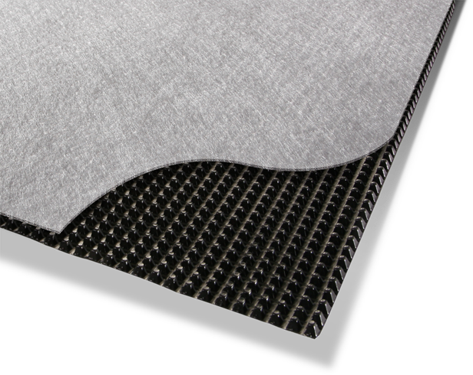
Figure 1: ABG Pozidrain
In order to demonstrate that ABG’s products are as resistant to landfill leachate as their component materials are known to be, a real world programme of testing has been undertaken to complement the existing range of laboratory testing already conducted, and provide confidence that ABG products will not degrade when exposed to landfill leachate.
This document is an interim report presenting the results of testing so far. The testing is ongoing and will be monitored for several more years.
Test Method
The testing undertaken involves immersing ABG products in a landfill leachate lagoon, extracting sets of samples at selected intervals over many months, and undertaking standard laboratory tests on both the extracted samples and identical control samples.
Test Location
The location selected for testing was a municipal waste disposal facility called Erin Landfill. Operated by Viridor, Erin Landfill is located near Chesterfield in Derbyshire, United Kingdom. With the permission of Viridor, the upper leachate pond at Erin Landfill was chosen as a suitable location to provide a representative environment where product samples could be submerged for extended periods of time. Viridor have also supplied some chemical monitoring results from the leachate ponds which are shown below in Figure 3.
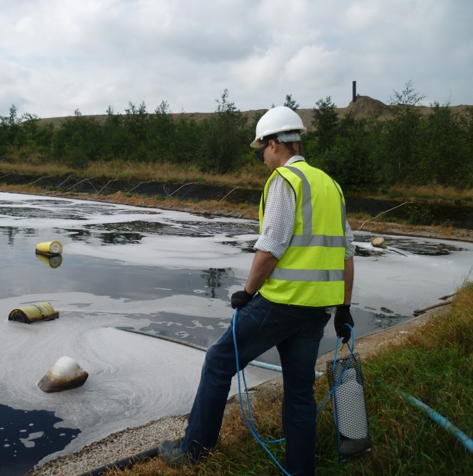
Figure 2: Test Sample Installation
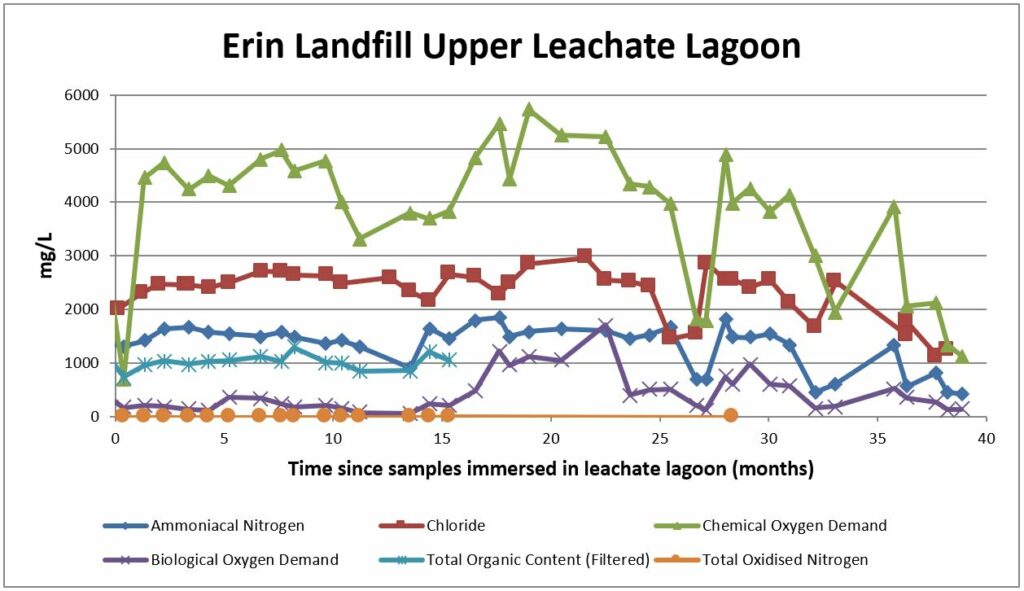
Figure 3: Erin Landfill Upper Leachate Lagoon – Monitored Water Properties
Products Tested
ABG is well-known for its range of Pozidrain drainage geocomposites. For this reason the selection of products tested was focused in this area. Pozidrain comprises a cuspated High Density Polyethylene (HDPE) drainage core with a Polypropylene (PP) geotextile, which is laminated to the drainage core in a polyolefin based heat bonding process. All standard Pozidrain products use the same material to manufacture HDPE cores of various sizes – so the drainage core from Pozidrain 4S250 was selected for inclusion in the testing. The specific geotextile used may vary depending on the application. Typically, the NW range is used – so NW8, S10NW and NW20XUV were included. NW8 and S10NW are 120g/m2 geotextiles, and NW20XUV is a 250g/m2 geotextile with enhanced UV stabilisation.
Laboratory Test Schedule
The attributes of the products tested were as follows:
- Mass per unit area (g/m2) as measured in accordance with EN ISO 9864 (both the HDPE core and all geotextiles tested to this standard).
- Tensile Strength as measured in accordance with BS EN ISO 12226:2012 (both the HDPE core and all geotextiles tested to this standard).
- Compressive Properties (kN/m2) at various strain values in accordance with ASTM D1621-10 Section 9 (HDPE core only).
- Puncture Resistance (aka CBR) (force, kN, and displacement, mm) as measured in accordance with BS EN ISO 12236:2006 (geotextiles only).
- Through Plane Flow (l/m2·s) as measured in accordance with BS EN ISO 11058:2010 (geotextiles only).
It should be noted that the Through Plane Flow tests were added to the schedule part-way through the immersion of the samples in the leachate lagoon. As such, test results are only registered from 18 months onwards.
Results
The results of the testing show very little variation in any of the properties measured. Each property and its test results are outlined and discussed below.
Material Mass
The purpose of this test was to determine whether any of the products have lost any mass whilst immersed in leachate. Each sample was carefully weighed before being immersed in leachate (test sample) or placed in UV protected storage (control sample). Once removed from the leachate lagoon, the samples were lightly cleaned to remove loose particulate debris before weighing. The results shown that the mass of all materials tested has remained unchanged (see Figure 4).
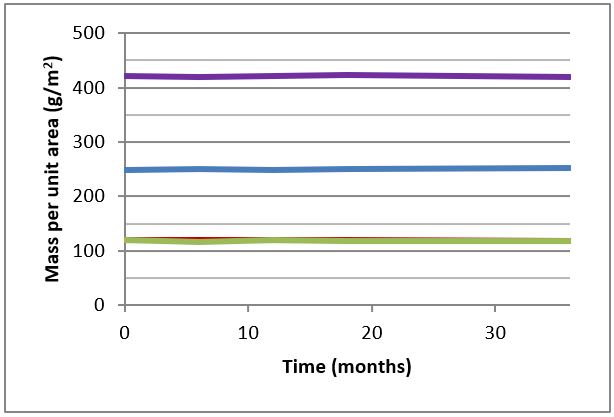
Figure 4: Material Mass
Tensile Strength
The purpose of this test was to see whether the strength or stiffness of the materials tested changes when immersed in leachate. This test generally has a higher variance in strain readings due to inherent variations in the material tested. The results show that there is a slight decrease in strain in the geotextiles (i.e. the material is becoming slightly stiffer), although this is, on average, within 1.6 standard deviations from the mean. Other than an anomaly after 12 months in the NW20XUV, the ultimate tensile strength remains unchanged (see Figure 5).
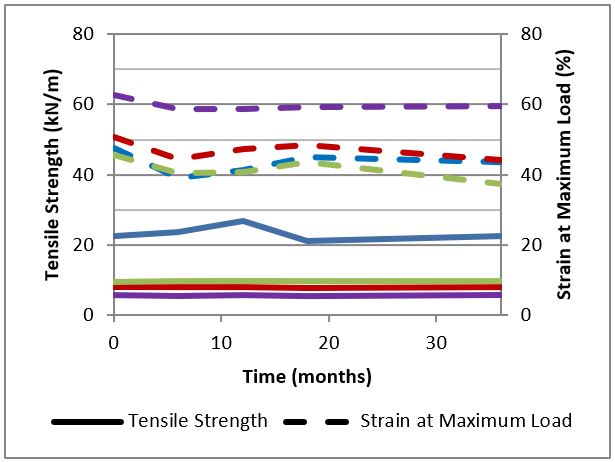
Figure 5: Tensile Strength
Compressive Properties of HDPE Core
The compressive properties of the cuspated HDPE core of the Pozidrain have been checked to see if there is any softening which may lead to a change in the drainage capacity of the geocomposite. This test generally has a higher variance due to the lower accuracy of the test method and variation in the material tested. This explains the gently undulating lines shown in the results. However, the overall trend is that emersion in leachate had no effect on the compressive properties of the HDPE core (see Figure 6).
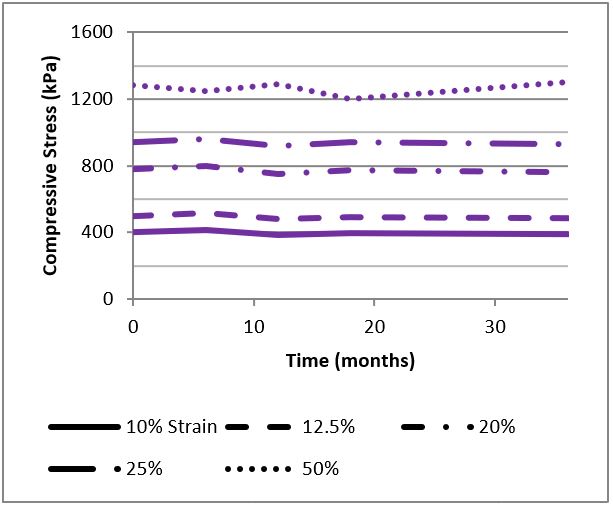
Figure 6: Compressive Properties
CBR Puncture Resistance of PP Geotextiles
The puncture resistance of a non-woven geotextile is an indicator of how effective the geotextile is at protecting the layer below from damage (e.g. a waterproof membrane). This test also has a higher variance due to the variation in the materials tested. The displacement measurements show a decrease in displacement that is also, on average, within 1.6 standard deviations of the mean. This indicates that the material may be getting stiffer – as noted in the tensile strength tests. Generally the ‘push through’ force is constant with an average increase in strength of 9%, although this is only 0.9 standard deviations from the mean (see Figure 7).
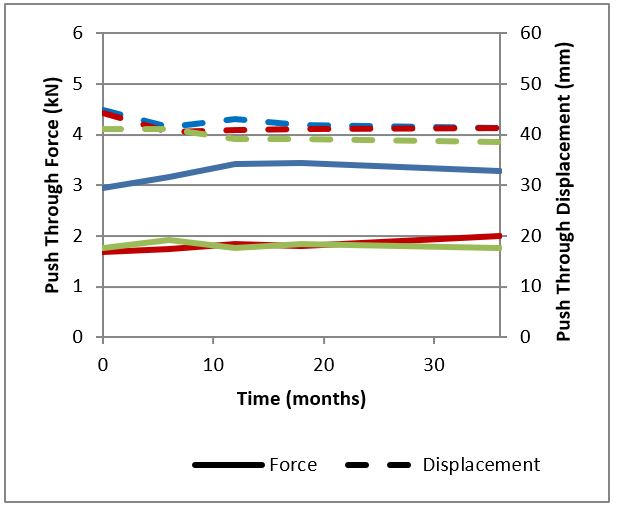
Figure 7: CBR Puncture Resistance
Through Plane Flow of PP Geotextiles
The Through Plane Flow test results provide an indication as to whether clogging of the geotextile is occurring. This test has an inherently large variability on non-woven geotextiles with a stated co-efficient of variation of 15-18% for the materials tested. After 18 months the values varied from 35% higher than the initial conditions to 44% lower. After 36 months this variation was less, from 11% higher to 20% lower. However, when compared to the control samples which were weight matched to the immersed samples, the variation shows a more consistent trend of typically 15-33% lower after 18 months, and 8-11% lower after 36 months. This may indicate reduced through plane flow in the geotextiles. However, given the variability of the results, it is not a clear trend (see Figure 8).
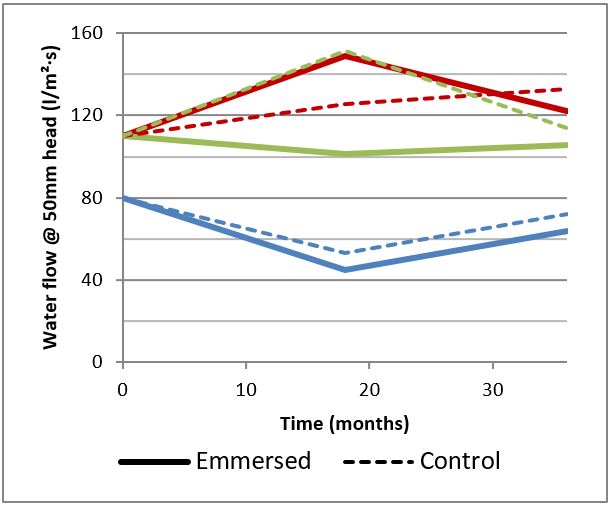
Figure 8: Through Plane Flow

Conclusion
The results of testing after 36 months of immersion in a municipal waste leachate lagoon indicate that there is generally very little change in the material properties of any of the geosynthetics tested. This is as expected due to the known chemical resistance of the constituent materials (HDPE and PP). The most variable result is the Through Plane Flow (vertical flow of groundwater into the drainage geocomposite) which shows a possible trend of around 10% reduction in through plane flow capacity. However, even the lowest measured result is still significantly more than is required in a landfill. The overall conclusion that can be drawn from this report is that leachate has no significant effect on the performance of ABG Pozidrain.